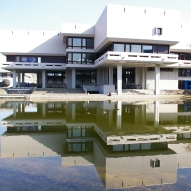Zusammenfassung
Dryland slopes, fluvial fans and terraces are recognized as highly sensitive process-response systems and important geoarchives for the reconstruction of palaeoclimatic driven landscape development in Southern Africa. The aim of this study is to study a dryland drainage system with a clearly limited regional catchment area, whose drainage and sedimentation behavior is unaffected by distant ...
Zusammenfassung
Dryland slopes, fluvial fans and terraces are recognized as highly sensitive process-response systems and important geoarchives for the reconstruction of palaeoclimatic driven landscape development in Southern Africa. The aim of this study is to study a dryland drainage system with a clearly limited regional catchment area, whose drainage and sedimentation behavior is unaffected by distant meteorological events or changes in climatic outside the region. Our results highlight for the first time the widespread occurrence of fluvial and lacustrine sediments in the Naukluft Mts. foreland as part of the Great Escarpment and their potential as Late Quaternary geoarchives. The region's special interest and overarching value lies (i) in the bounded catchments of both the lacustrine BtillsPort Playa and the ephemeral rivers Tsauchab and Tsondab within the South African Great Escarpment and (ii) in the rivers' endorheic character and dead ends within the Namib Sand Sea to the West. All these lacustrine and fluvial systems first and foremost exclude supra-regional influences within the flow regime. Uniquely, the key palaeoclimatic question of periodical shifts of the rainfall zones during Holocene and Late Glacial times can be studied in both these catchments. This study also combines new data from the semi-desert environment of the Naukluft Mts. with data from the terminus sites Sossusvlei and Tsondabvlei within the Namib dunes. From our interpretation of the desert flash flood series, the drainage history from pre-LGM times within MIS 3 up to modem times is represented in our data. The Late Tennination I was the period with the highest flow rates post MES3, raising the Urikos Terrace. This must have been caused by strong monsoonal rainfall events from summer TTT, giving rise to extreme flash floods. Little Ice Age sediments have filled the entire thalweg, with the exception of remnant Holocene to MIS 3 terraces to the sides and provide a unique framework for ecological conditions.




 Altmetric
Altmetric